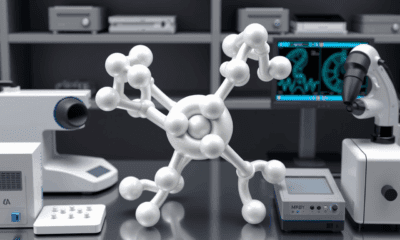While we try to keep things accurate, this content is part of an ongoing experiment and may not always be reliable.
Please double-check important details — we’re not responsible for how the information is used.
Detectors
Harnessing Ultrasound Waves to Control Solid Particles in Liquids: A New Frontier in Biomedical Research
Researchers have detailed the physics behind a phenomenon that allows them to create spin in liquid droplets using ultrasound waves, which concentrates solid particles suspended in the liquid. The discovery will allow researchers to engineer technologies that make use of the technique to develop applications in fields such as biomedical testing and drug development.

Chemistry
Scientists Stunned by Record-Breaking, Watermelon-Shaped Nucleus: Breakthrough Discovery in Nuclear Physics
Scientists in Finland have measured the heaviest known nucleus to undergo proton emission, discovering the rare isotope 188-astatine. It exhibits a unique shape and may reveal a new kind of nuclear interaction.
Chemistry
From Lead to Gold in a Fraction of a Second at the Large Hadron Collider
At the Large Hadron Collider, scientists from the University of Kansas achieved a fleeting form of modern-day alchemy — turning lead into gold for just a fraction of a second. Using ultra-peripheral collisions, where ions nearly miss but interact through powerful photon exchanges, they managed to knock protons out of nuclei, creating new, short-lived elements. This breakthrough not only grabbed global attention but could help design safer, more advanced particle accelerators of the future.
Cosmic Rays
The Nuclear Clock That Could Unmask Dark Matter
Physicists are exploring thorium-229’s unique properties to create a nuclear clock so precise it could detect the faintest hints of dark matter. Recent measurement advances may allow scientists to spot tiny shifts in the element’s resonance spectrum, potentially revealing the nature of this mysterious substance.
-

 Detectors8 months ago
Detectors8 months agoA New Horizon for Vision: How Gold Nanoparticles May Restore People’s Sight
-

 Earth & Climate9 months ago
Earth & Climate9 months agoRetiring Abroad Can Be Lonely Business
-

 Cancer9 months ago
Cancer9 months agoRevolutionizing Quantum Communication: Direct Connections Between Multiple Processors
-

 Albert Einstein10 months ago
Albert Einstein10 months agoHarnessing Water Waves: A Breakthrough in Controlling Floating Objects
-

 Earth & Climate9 months ago
Earth & Climate9 months agoHousehold Electricity Three Times More Expensive Than Upcoming ‘Eco-Friendly’ Aviation E-Fuels, Study Reveals
-

 Chemistry9 months ago
Chemistry9 months ago“Unveiling Hidden Patterns: A New Twist on Interference Phenomena”
-

 Agriculture and Food9 months ago
Agriculture and Food9 months ago“A Sustainable Solution: Researchers Create Hybrid Cheese with 25% Pea Protein”
-

 Diseases and Conditions10 months ago
Diseases and Conditions10 months agoReducing Falls Among Elderly Women with Polypharmacy through Exercise Intervention





























